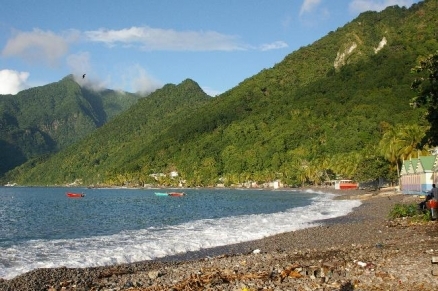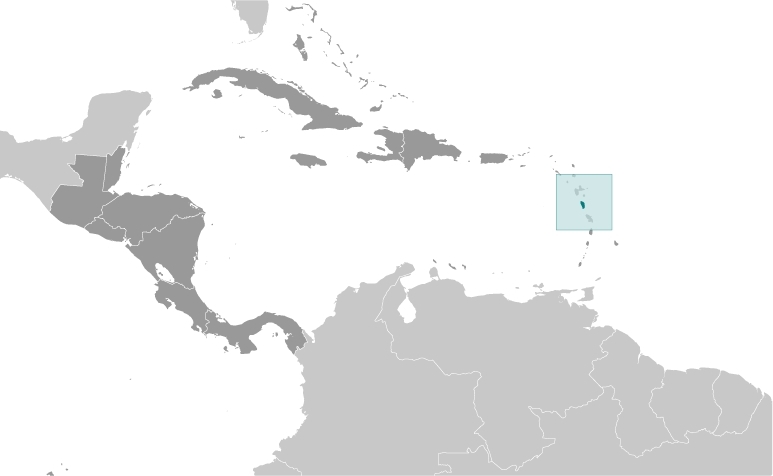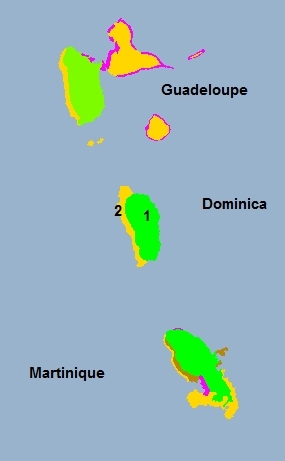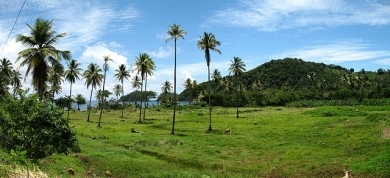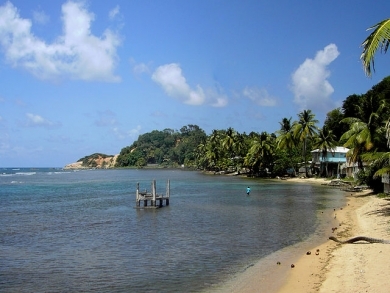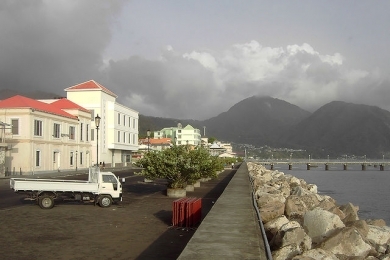Dominica
Countries and Regions of the World Collection  Dominica is an island nation of about 73,000 people between the Caribbean Sea and the North Atlantic Ocean, about half way between Puerto Rico and Trinidad and Tobago.
Dominica is an island nation of about 73,000 people between the Caribbean Sea and the North Atlantic Ocean, about half way between Puerto Rico and Trinidad and Tobago.
It known as "The Nature Island of the Caribbean" due to its spectacular, lush, and varied flora and fauna, which are protected by an extensive natural park system.
The most mountainous of the Lesser Antilles, its volcanic peaks are cones of lava craters and include Boiling Lake, the second-largest, thermally active lake in the world.
Flash floods are a constant threat in Dominica and destructive hurricanes can be expected during the late summer months.
Dominica was the last of the Caribbean islands to be colonized by Europeans due chiefly to the fierce resistance of the native Caribs. 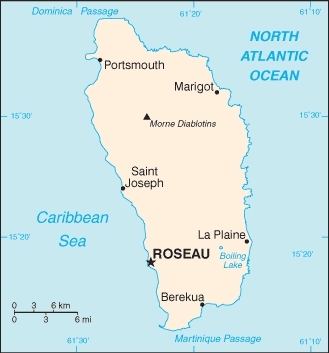
France ceded possession to Great Britain in 1763, which made the island a colony in 1805.
In 1980, two years after independence, Dominica's fortunes improved when a corrupt and tyrannical administration was replaced by that of Mary Eugenia Charles, the first female prime minister in the Caribbean, who remained in office for 15 years.
Some 3,000 Carib Indians still living on Dominica are the only pre-Columbian population remaining in the eastern Caribbean.
Contents
Geography
Location: Caribbean, island between the Caribbean Sea and the North Atlantic Ocean, about half way between Puerto Rico and Trinidad and Tobago
Geographic Coordinates: 15 25 N, 61 20 W
Area: 751 sq km
Coastline: 148 km
Maritime Claims:
territorial sea: 12 nm
contiguous zone: 24 nm
exclusive economic zone: 200 nm
Natural Hazards: flash floods are a constant threat; destructive hurricanes can be expected during the late summer months
Terrain: rugged mountains of volcanic origin. The highest point is Morne Diablotins (1,447 m).
Climate: tropical; moderated by northeast trade winds; heavy rainfall.
Ecology and Biodiversity
|
1. The Windward Islands moist forests (green) ecoregion is found in much of the central portion of each of the Caribbean’s Windward Islands and is characterized by rugged mountains, lush tropical vegetation and high annual rainfall. Specifically, this includes 70 to 95% of Dominica, Martinique, St. Lucia, St. Vincent, and Grenada. This is some of the most biologically rich and diverse ecoregions in the Lesser Antilles, if not the entire Caribbean Basin. Steep mountains inhibit extensive human-related development while abundant annual rainfall has allowed for great floral and faunal diversity. The vegetation in Dominica’s forests, for example, comprises over one thousand species of flowering plants with about sixty woody plant and tree species per hectare (ha). The region is home to four islands in this ecoregion suffer from similar human-related pressures, i.e., agricultural encroachment, hunting, and limited enforcement of wildlife and environmental legislation. Increased communication, networking, and effort of conservation on a regional basis are needed to ensure that these rich forests and their wildlife are maintained and protected. The biologically rich forests of this ecoregion have drawn much conservation attention and consequently several important protected areas exist. Notable examples are Morne Trois Pitons National Park (6,840 ha) and the Northern Forest Reserve (22,000 ha) in Dominica, Dominica still has large undisturbed montane forests that are regionally significant but inadequately protected. The Minister of Agriculture is able to set up protected areas under the authorization of the National Parks and Protected Areas Act and terrestrial wildlife is protected under the Forestry and Wildlife Act. Perhaps the most fundamental problem facing the managers of Dominica's forests is the rapidly expanding pressure on the forest resources as a source of timber, fuelwood and charcoal, and as areas increasingly utilized for crop cultivation. Regionally, two aspects of current forestry legislation are considered weak, penalties for forest offenses are too low for deterrence, and there is no mechanism for ongoing co-ordination of decision-making between forestry and other sectors concerning land-use planning and development control. 2. The northern and western edge of Dominica is included within the Windward Islands xeric scrub ecoregion (yellow), an area impacted by a relatively high population (70% of the island’s population lives on the flatter, western (leeward) side of the island) and extensive [[agricultural] development]; circumstances that bring associated problems such as introduced exotics and habitat alteration. |
Ecoregions of Dominica (middle island). Source: World Wildlife Fund |
See also:
- Protected areas of Dominica
- Common coral reef fishes of Dominica
- Biological diversity in the Caribbean Islands
People and Society
Population: 73,126 (July 2012 est.)
Almost all Dominicans are descendants of enslaved Africans brought in by colonial planters in the 18th century. Dominica is the only island in the eastern Caribbean to retain some of its pre-Columbian population--the Carib Indians--about 3,000 of whom live on the island's east coast. The population growth rate is very low, due primarily to emigration to more prosperous Caribbean Islands, the United Kingdom, the United States, and Canada.
English is the official language; however, because of historic French domination, the most widely spoken dialect is a French-based Creole. Nearly 80% of the population is Catholic. In recent years, a number of Protestant churches have been established.
Ethnic Groups: black 86.8%, mixed 8.9%, Carib Amerindian 2.9%, white 0.8%, other 0.7% (2001 census)
| Coastal Dominica. Source: Dirk Heldmaier/Wikimedia Commons |
| Interior Dominica. Source: Dirk Heldmaier/Wikimedia Commons |
| Calibishie in northeastern Dominica. Source: Hans Hillewaert/Wikimedia Commons |
| Roseau. Source: Hans Hillewaert/Wikimedia Commons |
Age Structure:
0-14 years: 22.9% (male 8,551/female 8,188)
15-64 years: 66.8% (male 25,007/female 23,730)
65 years and over: 10.3% (male 3,246/female 4,247) (2011 est.)
Population Growth Rate: 0.216% (2012 est.)
Birthrate: 15.6 births/1,000 population (2012 est.)
Death Rate: 8.03 deaths/1,000 population (July 2012 est.)
Net Migration Rate: -5.42 migrant(s)/1,000 population (2012 est.)
Life Expectancy at Birth: 76.18 years
male: 73.23 years
female: 79.29 years (2012 est.)
Total Fertility Rate: 2.06 children born/woman (2012 est.)
Languages: English (official), French patois
Literacy (age 15 and over can read and write): 94% (2003 est.)
Urbanization: 67% of total population (2010) growing at an annual rate of change of 0.3% (2010-15 est.)
History
The island's indigenous Arawak people were expelled or exterminated by Caribs in the 14th century. Columbus landed there in November 1493. Spanish ships frequently landed on Dominica during the 16th century, but fierce resistance by the Caribs discouraged Spain's efforts at settlement.
In 1635, France claimed Dominica. Shortly thereafter, French missionaries became the first European inhabitants of the island. Carib incursions continued, though, and in 1660, the French and British agreed that both Dominica and St. Vincent should be abandoned. Dominica was officially neutral for the next century, but the attraction of its resources remained; rival expeditions of British and French foresters were harvesting timber by the start of the 18th century.
Largely due to Dominica's position between Martinique and Guadeloupe, France eventually became predominant, and a French settlement was established and grew. As part of the 1763 Treaty of Paris that ended the Seven Years' War, the island became a British possession. In 1778, during the American Revolutionary War, the French mounted a successful invasion with the active cooperation of the population. The 1783 Treaty of Paris, which ended the war, returned the island to Britain. French invasions in 1795 and 1805 ended in failure.
In 1763, the British established a legislative assembly, representing only the white population. In 1831, reflecting a liberalization of official British racial attitudes, the Brown Privilege Bill conferred political and social rights on free nonwhites. Three Blacks were elected to the legislative assembly the following year. Following the abolition of slavery, in 1838 Dominica became the first and only British Caribbean colony to have a Black-controlled legislature in the 19th century. Most Black legislators were smallholders or merchants who held economic and social views diametrically opposed to the interests of the small, wealthy English planter class. Reacting to a perceived threat, the planters lobbied for more direct British rule.
In 1865, after much agitation and tension, the colonial office replaced the elective assembly with one comprised of one-half elected members and one-half appointed. Planters allied with colonial administrators outmaneuvered the elected legislators on numerous occasions. In 1871, Dominica became part of the Leeward Island Federation. The power of the Black population progressively eroded. Crown Colony government was re-established in 1896. All political rights for the vast majority of the population were effectively curtailed. Development aid, offered as compensation for disenfranchisement, proved to have a negligible effect.
Following World War I, an upsurge of political consciousness throughout the Caribbean led to the formation of the Representative Government Association. Marshaling public frustration with the lack of a voice in the governing of Dominica, this group won one-third of the popularly elected seats of the legislative assembly in 1924 and one-half in 1936. Shortly thereafter, Dominica was transferred from the Leeward Island Administration and was governed as part of the Windwards until 1958, when it joined the short-lived West Indies Federation.
After the federation dissolved, Dominica became an associated state of the United Kingdom in 1967 and formally took responsibility for its internal affairs. On November 3, 1978, the Commonwealth of Dominica was granted independence by the United Kingdom.
Independence did little to solve problems stemming from centuries of economic underdevelopment, and in mid-1979, political discontent led to the formation of an interim government. It was replaced after the 1980 elections by a government led by the Dominica Freedom Party under Prime Minister Eugenia Charles, the Caribbean's first female prime minister. Chronic economic problems were compounded by the severe impact of hurricanes in 1979 and in 1980. By the end of the 1980s, the economy recovered, but weakened again in the 1990s due to a decrease in banana prices. In the 2000s, the economy was hit by a spate of disasters, including the removal of the European preferential trade for bananas, the impact of Hurricane Dean, and the global financial meltdown. Dominica has managed quite well during the current global recession as a smaller percentage of its economy is based on tourism and foreign investment.
In the January 2000 elections, the Edison James United Workers Party (UWP) was defeated by the Dominican Labour Party (DLP), led by Roosevelt P. "Rosie" Douglas. Douglas died after only a few months in office and was replaced by Pierre Charles, who died in office in January 2004. Roosevelt Skerrit, also of the DLP, replaced Charles as Prime Minister. Under Prime Minister Skerrit's leadership, the DLP won elections in May 2005 and in December 2009. In 2009, the DLP won 18 of the 21 constituencies, with the UWP collecting 3 seats. Currently the opposition has decided to boycott parliament over allegations of campaign improprieties. Due to the absence in parliament of 2 UWP members, the government held by-elections on July 9, 2010 with both seats won by the UWP.
Government
Dominica has a Westminster-style parliamentary government, and there are two major political parties--the Dominica Labour Party (the majority party), and the Dominica United Workers Party. The Dominica Freedom Party has lost its party base and is no longer a factor in elections. A president and prime minister make up the executive branch. Nominated by the prime minister in consultation with the leader of the opposition party, the president is elected for a 5-year term by the parliament. The president appoints as prime minister the leader of the majority party in the parliament and also appoints, on the prime minister's recommendation, members of the parliament from the ruling party as cabinet ministers. The prime minister and cabinet are responsible to the parliament and can be removed on a no-confidence vote.
The unicameral parliament, called the House of Assembly, is composed of 21 regional representatives and nine senators. The regional representatives are elected by universal suffrage and, in turn, decide whether senators are to be elected or appointed. If appointed, five are chosen by the president with the advice of the prime minister and four with the advice of the opposition leader. If elected, it is by vote of the regional representatives. Elections for representatives and senators must be held no later than 5 years after the first meeting of parliament, although the prime minister can call elections any time. The last election was held in December 2009.
Councils elected by universal suffrage govern most towns. Supported largely by property taxation, the councils are responsible for the regulation of markets and sanitation and the maintenance of secondary roads and other municipal amenities. The island is also divided into 10 parishes, whose governance is unrelated to the town governments.
Government Type: Parliamentary democracy.
Capital: Roseau - 14,000 (2009)
Administrative divisions: 10 parishes; Saint Andrew, Saint David, Saint George, Saint John, Saint Joseph, Saint Luke, Saint Mark, Saint Patrick, Saint Paul, Saint Peter
Independence Date: 3 November 1978 (from the UK)
Legal System: Dominica's legal system is based on English common law. Dominica accepts compulsory International Court of Justice (ICJ) jurisdiction; and accepts International criminal court (ICCt) jurisdiction. There are three magistrate's courts, with appeals made to the Eastern Caribbean Court of Appeal and, ultimately, to the Privy Council in London.
Roueau. Source: Ted Rufus Ross/Wikimedia Commons.
International Environmental Agreements
Dominica is party to international agreements on: Biodiversity, Climate Change, Climate Change-Kyoto Protocol, Desertification, Endangered Species, Environmental Modification, Hazardous Wastes, Law of the Sea, Ozone Layer Protection, Ship Pollution, and Whaling.
Water
Freshwater Withdrawal: 0.02 cu km/yr
Per Capita Freshwater Withdrawal: 213 cu m/yr (1996)
See: Water profile of Dominica
Resources
Natural Resources: timber, hydropower, arable land
Land Use:
Economy
The Dominican economy has been dependent on agriculture - primarily bananas - in years past, but increasingly has been driven by tourism as the government seeks to promote Dominica as an "ecotourism" destination. In order to diversify the island's production base, the government also is attempting to develop an offshore financial sector and has signed an agreement with the European Union to develop geothermal energy resources.
Many consider Dominica's economic situation the most challenging of all the Eastern Caribbean states. While the economy has grown faster in more recent years, growth over the last decade was still under 1%. The country nearly had a financial crisis in 2003 and 2004. In 2003, the government began a comprehensive restructuring of the economy - including elimination of price controls, privatization of the state banana company, and tax increases - to address an economic and financial crisis and to meet IMF requirements.This restructuring paved the way for an economic recovery and helped to reduce the debt burden, which remains at about 80% of GDP
Growth in 2006 was attributed to gains in tourism, construction, offshore and other services, and some sub-sectors of the banana industry. The International Monetary Fund (IMF) recently praised the Government of Dominica for its successful macroeconomic reforms. The IMF also pointed out remaining challenges, including further reductions in public debt, increased financial sector regulation, and market diversification.
Bananas and other agriculture dominate Dominica's economy, and nearly one-third of the labor force works in agriculture. This sector, however, is highly vulnerable to weather conditions and to external events affecting commodity prices. In 2007, Hurricane Dean caused significant damage to the agricultural sector as well as the country's infrastructure, especially roads. In response to reduced European Union (EU) banana trade preferences, the government has diversified the agricultural sector by introducing coffee, patchouli, aloe vera, cut flowers, and exotic fruits such as mangoes, guavas, and papayas. Dominica has had some success in increasing its manufactured exports, primarily soap.
Dominica is mostly volcanic and has few beaches; therefore, tourism has developed more slowly than on neighboring islands. Nevertheless, Dominica's high, rugged mountains, rainforests, freshwater lakes, hot springs, waterfalls, and diving spots make it an attractive eco-tourism destination. Cruise ship stopovers have increased following the development of modern docking and waterfront facilities in the capital.
Dominica's currency is the Eastern Caribbean Dollar (EC$), a regional currency shared among members of the Eastern Caribbean Currency Union (ECCU). The Eastern Caribbean Central Bank (ECCB) issues the EC$, manages monetary policy, and regulates and supervises commercial banking activities in its member countries. The ECCB has kept the EC$ pegged at EC$2.7=U.S. $1.
Dominica is a beneficiary of the U.S. Caribbean Basin Initiative that grants duty-free entry into the United States for many goods. Dominica also belongs to the predominantly English-speaking Caribbean Community and Common Market (CARICOM), the CARICOM Single Market and Economy (CSME), and the Organization of Eastern Caribbean States (OECS).
Hurricane Dean struck the island in August 2007 causing damages equivalent to 20% of GDP.
In 2009, growth slowed as a result of the global recession; it picked up only slightly in 2010-11.
GDP: (Purchasing Power Parity): $1.02 billion (2011 est.)
GDP: (Official Exchange Rate): $500 million (2011 est.)
GDP- per capita (PPP): $13,600 (2011 est.)
GDP- composition by sector:
agriculture: 21.4%
industry: 22.4%
services: 56.3% (2011 est.)
Agricultural products: bananas, citrus, mangos, root crops, coconuts, cocoa. Note: forest and fishery potential not exploited
Industries: soap, coconut oil, tourism, copra, furniture, cement blocks, shoes
Currency: East Caribbean dollars (XCD)
